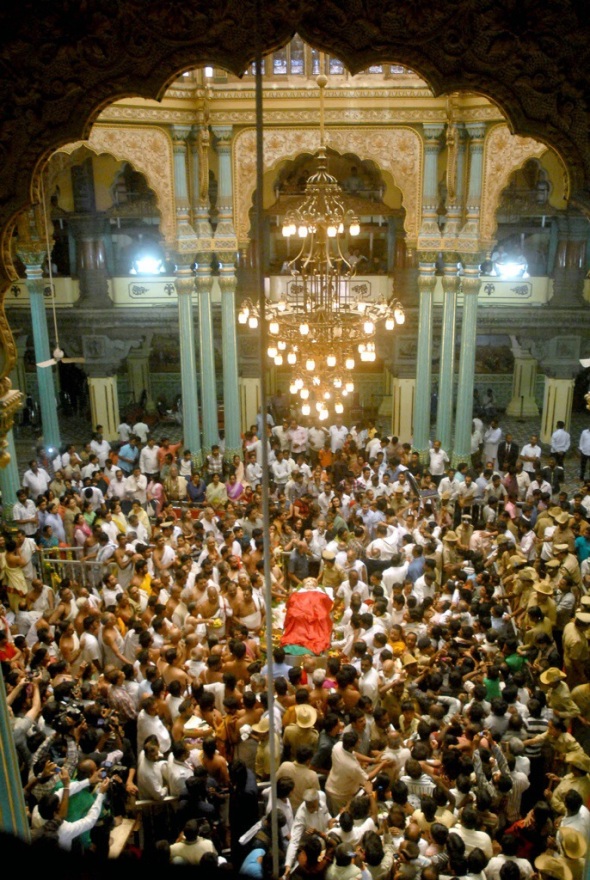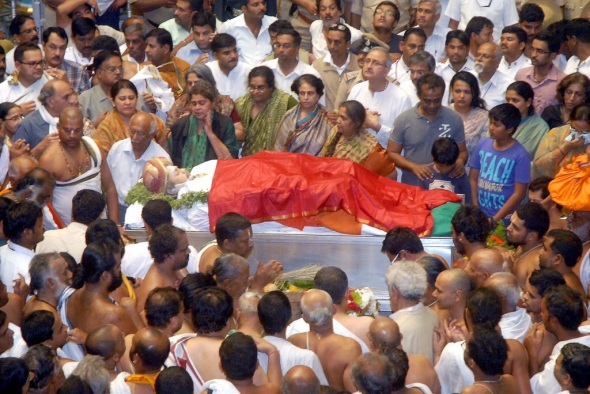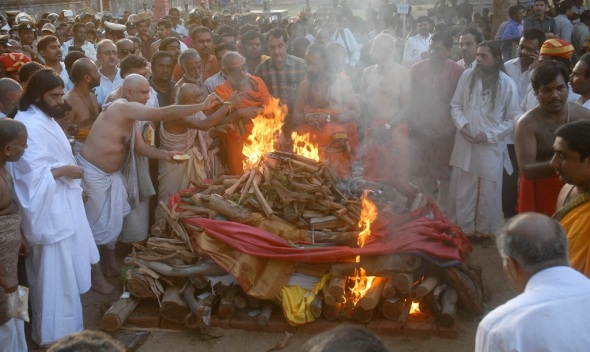The rest of democratic India that is Bharat—indeed, the rest of Karnataka that is not Mysore and Bangalore—will not understand the fuss over the passing of Srikantadatta Narasimharaja Wodeyar, the last link to the rajas and maharajas of Mysore, who lorded over a tiny five-star kingdom for 614 years.
Although Srikantadatta’s own role, even as a member of Parliament, may have been infinitesimal in the republican era, the imprint that the benign and benevolent royals left on generations of Mysoreans is immense: in our education, in our arts and culture, in our attitudes, in our palaces, roads, gardens and clubs.
Here, one grateful 22-carat Mysorean pays a 21-gun salute.
***
Mysore of the 1970s when I was growing up as a young boy.
There was an air of well-proportioned dignity to it; a rare kind of regality; a sense of easy sophisticated charm; in the quietude and tranquilLity that pervaded the air like a gossamer thin veil, a kind of strange allure that no other place in the rest of Karnataka possessed.
It showed in its beautifully laid out streets; quiet, broad, tree-lined, leafy and handsome. And in the magnificent but slightly dulled mansions of Lakshmipuram with their delicate fountains, more often than not with the statuette of Lord Krishna, standing with his right leg elegantly over his left and a flute to his lips.
In the bungalows of Vontikoppal with their bougainvillea-smothered porticos, where invariably stood in grand aloofness, a car, mostly either a stately black Ambassador or an Austin of indeterminable vintage, a subtle indication of a certain exaltedness.
And in the greying grandioseness of the homes of the privileged. European in style and dimensions, with their wood latticed windows and many structured floors, their green gardens with red geranium creepers hanging from moss covered earthen pots in the balconies.
In Nazarbad and on the rain-tree lined street leading up to that white beauty of splendid stature, the Lalitha Mahal palace, nestling under the imposing omniscience of the Chamundi Hill.
Inside these mansions could be found Mysore style paintings in gold.
Paintings of goddess Chamundi, astride on a lion.
Or a beautiful swing with its ivory in-lay showing delicate flowers and mango motifs.
Or a rattan sofa.
Or a teak or a rose wood one, with its cushions in cream and white.
The massive black head of a gaur or a chital with its huge antlers fixed to the walls around, trophies from a long concluded hunt in the awesome jungles of Bandipur or Kakanakote, not too far from Mysore.
Mysore was unique.
A kind of baby of the Wodeyars, the kings of the dynasty that ruled for an impossibly long 600 and odd years. A baby born into serious privilege. A baby that had everything laid out for it.
Mysore was like none other. For sure. The Maharajas showered it with the kind of luxurious abundance that no other town or city in the state could ever imagine.
So fascinatingly royal in its demeanour and style.
So laid back and mellow.
So very easy in its manner.
The Mysorean was a gentle, soft-spoken, easy-going kind of man for whom the din and tumult of a Bangalore or Bombay was anathema; a kind of culture shock which left him dumb founded.
Not to him the mindlessness of heavy traffic, not to him the frenzied pace of business, not to him the rush hours of life where clambering on to a bus or a train defines the difference between success and failure.
To the Mysorean, life was almost always meant to be an unhurried, relaxed, quiet and elaborate repast. And even to this day, it is largely so.
At the many social clubs that you find in the city. All set up by the Maharajas.
Like the Cosmopolitan Club, the Narasimharaja Sports Club, the Race Club and the Jayachamaraja Wadiyar Golf Club. Where many an evening has been spent observing intellectuals discussing and debating weighty matters of scholarship and the casual gentry deliberating on the timing of Sachin Tendulkar’s retirement!
Over soothing glasses of scotch of course!
The royals of Mysore gave to the city a kind of atmosphere where there could be seen a sense of luminous exuberance in the general affairs of existence.
The impact of the Maharajas could be felt everywhere. In the manner in which stood the royal palace built out of fine grey granite in the heart of the city with its deep pink marble domes, under whose amazing arches on the day of Vijayadashami, erstwhile Maharajas climbed on to the magnificently caparisoned royal elephant with its shimmering silks and glistening ivory tusks covered in a sheath of shiny gold.
In the slightly standoffish seclusion of the Rajendra Vilas palace in the distance, perched like an eagle’s nest at the edge of the Chamundi Hill where not too many Mysoreans ventured, even when it was being run as a luxury hotel.
In the red turrets of the Gun House next to the main palace, a tony bar and restaurant in the early 80’s, where you found some exquisite continental fare served by liveried waiters in an atmosphere of absolute mellowness, to the accompaniment of cool, soft, easy English numbers sung by a portly singer called Saby who rode an old but well preserved Yezdi to work.
In its culture of music concerts during Rama Navami and Dasara. Where some of the greatest and the most accomplished of singers and instrumentalists from around the country felt it a singular honour to perform.
In the manner in which the University was shaped. Where some of the brightest and most sharp minds came to teach. Like Dr Sarvepalli Radhakrishnan, a professor of philosophy at the Maharaja’s College, then one of the most revered institutions of learning in the country.
Like Professors J.C. Rollo, A.B. Mackintosh, W.G. Eagleton, B.M. Srikantaiah and S.V. Ranganna.
Inside whose classrooms with their teak wood tables and benches sat, as students, the likes of M.N. Srinivas, H.Y. Sharada Prasad, T.S. Satyan, ‘Veene’ Doreswamy Iyengar, R. K. Narayan, U.R. Anantha Murthy, P. Lankesh, Kuvempu, Ta.Su. Shama Rao, G.S. Shivarudrappa; the list of the great and the prodigious can go on.
The campus housing the departments of higher learning, so poetically named Manasagangotri.
Where stands, sentinel like, the Jayalakshmi Vilas palace, that takes you back even now, to the time of the 1800s, when Mysore was a tiny little town cocooned in kingly warmth; a reminder of the munificence of the royal family which gifted hundreds of acres of their personal property for the cause of setting up these post graduate schools of learning as they exist today, amidst a profusion of greenery and wooded bliss.
Where apart from students, you find walkers and exercisers of all shapes and sizes, willingly getting their daily fix of muscle toning activity. A lung space so beautiful and leafy, it could perhaps be compared to the ones in the universities in distant England, especially after the cricket ground named Gangotri Glades, one of the prettiest in the whole country, was developed!
As the orange hued flames begin to lick the sandalwood pyre of Srikantadatta Narasimharaja Wodeyar, veritably the last of the royals of Mysore, the mind stills and the heart aches.
Perhaps in the deep longing for the Mysore that his ancestors created and left behind or in the feeling that all good things, as the old line goes, shall never last forever.
Photographs: Karnataka Photo News
Also read: My daddy, His Highness, the Maharaja of Mysore
Once upon a time, at the Maharaja’s study circle
When Bishen Bedi bowled from the Maharaja College end
Mutton chops, mudde and saaru with Srikantadatta Wodeyar
The maharaja’s elephant that made me a photographer
Rama, Rama rajya, and Nalwadi Krishnaraja Wodeyar






So, it is streets, mansions, palaces, paintings, furniture, a lack of industries, clubs, elephants, music concerts, and Mysore University, all eco-friendly.
LikeLike
Heads of dead animals, pontificating club bores, vapid Durban attendees- what an old fart of an article.
Mysore to me, a 9 carat Mysorean is Geeta Book Stores, panipuri near dodda gadiyara, Mylari Hotel, the steps of Chamundi Betta, the green expanse of Gangotri etc. I was really unmoved by the death of a man who always looked like he was sleeping.
LikeLike
The 1950s Mysore of my younger days lost its lustre by 1970s. When Mysore lost the B-state status in early years of independent India, it lost its glory its Maharaja became sadly irrelevant as the Congress politicians and politics entered the “pay-back” game. The great names in the professorial roster above were soon forgotten. It is a real shame. We erased the great history of a great royalty and with it the uniqueness of Mysore.
LikeLike
@Akshay S Dinesh:
For this reason you might wish to visit Mysore Again from Bangalore a Hedon. They had Vikrant Tyres thats CEAT or something now, even with lack of Industries, life has survived in Mysore, maybe nobody is renovating in the Business district, Nobody has done that even in Avenue road area. There is hope for Post Oil Civilization, If there will be less strife in India, its largely because we are mostly Vegetarian.
LikeLike
I believe the author has given a perception of what a Mysorean during that time has felt, thanks to the Royals, and not what a person might logically perceive. I personally feel this is a beautifully and frankly written article.
LikeLike
The State Government never bothered to showcase the legacy of the royals and the heritage that they left behind. Taking advantage of it it could have placed Mysore on par with countries abroad that have maintained their rich past. It did not even allow the royal family members to live peacefully and allow them to continue with their tradition. On the other hand, it pushed them to seek long drawn legal battles against its decisions and orders that affected them badly. If only it had preserved and continued with the past they left behind and allowed them to live peacefully, Mysore would have been a better cultural and heritage city, reflecting its glorious past. Sad indeed.
LikeLike
Well said Gaby. I too thought the article reeked elitism. It mostly missed what actually makes mysore mysore.
LikeLike
Karnataka is much more than Mysore for a simple citizen from North Karnataka. Yes, I am saddened by the death of any man, but I would be lying if I said I could relate the the royalty of the Mysore Maharajas. They meant very little to me and I am sure for many more denizens of Karnataka. Too bad he couldn’t reach beyond!
LikeLike
sunaad
well written. However a small factual error. the JWGC (golf club) was formed in 1984/85.
LikeLike
The article or the purpose is neither here nor there.! It doesn’t carry the essence of Mysore in any manner or its relation towards royal dynasty.
LikeLike
Wonder why they needed to burn 250kgs of sandal wood! It’d have demonstrated how progressive they were if his remains were confined to an electric crematorium instead.
Mysore Royal family was progressive, but it appears Last Late Mr. Wadiyar wasn’t so.
LikeLike
Gaby,
actually that unmoving guy got all things moving.
In 1970 his bank balance was cut by Indira and he had to borrow money for cremation.
You should hear to his interviews with MD Pallavi (on her facebook profile she has time to fight for gay rights (along with BJP Malavika) but she forgets even to mention Odeyar – because they are so made to believe he was impotent! and still they fight for minorities of Delhi – a cause which i believe they dont fully understand! These are the people who are sitting here ambitious to rule while people in california are busy commenting to such articles.
For others Odeyar was a leftist-communist and used to command purohitas if they recite mantra wrong . He commanded elephants ( for me this is the most manly of all ) and fought Psoriasis and Septicemia. what else you want from a King who looked after his family and fought for their rights when he was reduced to a single man (only on books – power was transferred to Delhi in actual terms ). As usual Kannadigas were made to believe democracy was good and everyone will get rights while the reality was that there was no need to fight a war. I have never seen any kind of rebellion within 500 km radius of mysore any point of time apart from those unwanted stories on Tippu for votebanks.
It’s so regressive to think on procreation terms and spreading it to glory even when they have studied science . Our people are the first to be ‘Manege maari Oorige upakari’. Wonder what genes your kins will use to backfire at you.
LikeLike
Strange. I grew up in Maisuru and almost never encountered the hallowed institutions mentioned. They were always there, but one never cared much about because they were for the “sawkaarru”.
My Maisuru was discovered as a young teen in endless bicycle trips – and later moped trips – the exploitation of new means of conveyances carefully hidden from the people who worried incessantly at home.
It was in the wonder of exploring the beautifully laid out localities of V.V.Mohalla, Krishnamurthypuram, Laxmipuram etc. with their conservancies and well spaced houses. Or realizing so many years later that I could go to my college, NIE, from Gokulam 3rd Stage without encountering a single traffic light along the way. Not because there wasn’t any traffic, but because a quick look or a nod or gentle braking usually orchestrated the smooth flow of (usually moped or scooter) traffic.
It was in walking past Kuvempu’s house, the agarbatti fueled mansions around Paparam House, or M.P.Shankar’s house, all in the span of a few minutes and realizing what a wonderful city this must be to host so many prominent people of so many different types!
Or looking at Prof.Aprameya Iyengar’s house with some old student or the other visiting to pay respects to the man who educated and mentored a generation of engineers in the city. Or going to Dr.Indiramma’s clinic in Vontikoppalu because you had a fever, but being excited to be walking through the little fruit and vegetable market nearby.
Or in more innocent times, going every week to Devaraja market for grocery shopping because the stuff closer to home was “too expensive”. And being stopped by far too many shopkeepers around the Chikka Gadiyara for a chat rather than a sale.
Or the incomparable Geetha Book House where you could buy any book you wanted, as long as you found it, and no one frowned at you for just lingering and browsing. Or getting yelled at by the communist crank who owned People’s Book House opposite the Jaganmohana Palace for having the temerity to soil his precious books with my grubby, disrespectful hands.
It was in being able to skip from communist book shop to imperial excess right across the street where any citizen could experience the luxuries of royalty for a few hours for just a few rupees.
It was in listening to older relatives – men usually – who still referred to the king as “Highness” – and having confused the pre and post independence eras, ended up attributing the few achievements of our democratic republic also to the Maharajas.
Whether any of these were the doing of the Wodeyars or not, just like my older relatives, I too don’t mind giving them the credit for creating a city which encourages nostalgia like no other.
LikeLike
We people of old mysore know the maharajas well…democracy didnt contribute anything to India..the corrupt politicians…irresponsible youths…
worst part is after 60years of Independance also..there is a gap between north karnataka and old mysore people…and we know the difference…
in terms os language..culture..everything…some people tried uniting but its against people’s wish…the difference continues for ever….the most improved districts of karnataka are of old mysore…..
thanks to our maharajas…who ruled …in a most truthful way…..
LikeLike
Raaja is but one of the many incarnations of the propagandist who tried years ago to sell us the story of the royals pawning their hard earned gold and diamonds to underwrite the construction of KRS (never mind the humility behind the naming of the dam). Now comes the precious story of there not being enough money for a cremation.
Ah, yes, the privy purse. The people–about two hundred–in my grandfather’s village could have led princely lives on a trace of that annual pension for no tangible service.
Then fiction attains legendary status. Someone said JCW was a commie.
My Lord, why hast thou forsaken us?
LikeLike